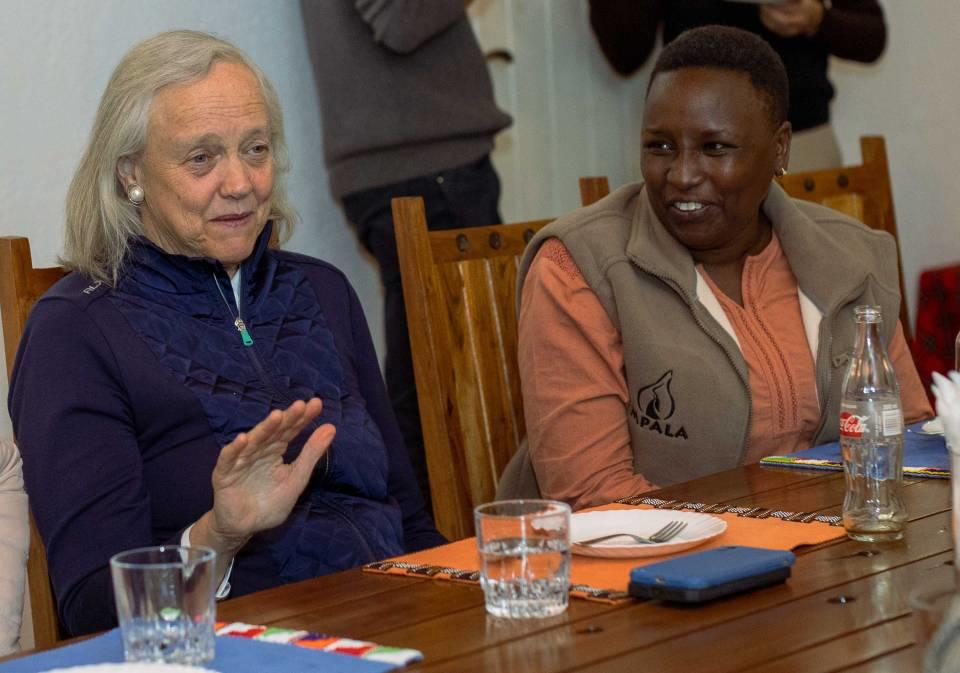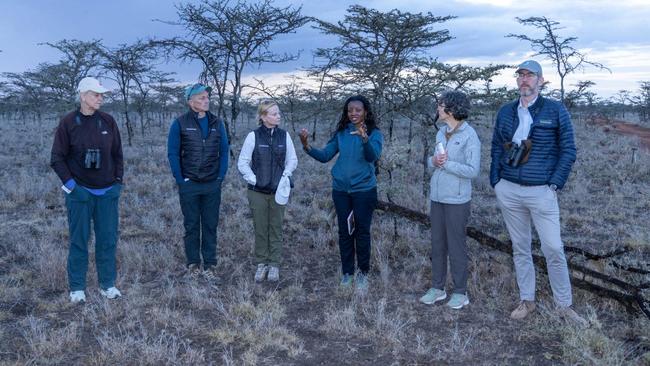Mpala Research Centre hosts U.S. Ambassador to Kenya Meg Whitman ’77

During fall break, a group of senior Princeton academic leaders and administrators — with expertise in infrastructure, operations, information technology, safety and facilities — visited the Mpala Research Centre in Laikipia County, Kenya, and were joined by the newly sworn-in U.S. Ambassador to Kenya Meg Whitman ’77 and her husband Dr. Griff Harsh for an overnight visit. Whitman, the former Hewlett Packard CEO and Princeton residential college namesake, was a mere 10 weeks into her role when she and a small retinue from the U.S. Embassy in Nairobi made the journey to tour the research center on Oct. 24.
Associate Provost for International Affairs and Operations Aly Kassam-Remtulla, who oversees the center, said he was especially excited to host the ambassador at Princeton’s Kenya-based center, since Mpala’s research often draws upon STEM disciplines, of which Whitman is a vocal proponent.
“I think she saw the possibilities for the center to expand its engagement in world-class science. She also saw the incredible importance of Mpala as an anchor in Laikipia County, in terms of livelihoods for the local community and in using science to develop solutions to determine how wildlife, cattle and human beings can live harmoniously together,” said Kassam-Remtulla, adding that Robert Godec, the U.S. Ambassador to Kenya during the Obama administration, visited the center more than once in his six years in that role. This is the second outing to Mpala organized by Kassam-Remtulla’s office this year; in the spring, he convened a group of Princeton faculty to tour the center and learn more about its multidisciplinary opportunities.
Jonathan Levine, department chair of Ecology and Evolutionary Biology (EEB), who was on the fall break journey, agreed that Mpala offers many research possibilities. “The Mpala center provides an unparalleled opportunity for Princeton faculty and students to interface with the special natural history, science and people of the region,” he said after returning. “It was immensely valuable to see firsthand the ecological and evolutionary studies being conducted by my colleagues at Princeton, and the special context for our undergraduate teaching based at the center.” EEB faculty have been active at Mpala since the research center was created in 1994.
As it nears its third decade, Mpala is at an important inflection point. The center is nearing the end of a comprehensive and inclusive strategic planning process. This has prompted Princeton to examine its stewardship role for the world-class research complex.
Additionally, a new executive director is set to be named in the coming weeks. That leader will play a critical role in expanding the research center’s partnerships, raising visibility at global scale, and investing in capacity-building for African scientists and scholars.
Mpala — which is a Kenyan nongovernmental organization – was created as a partnership of four entities including Princeton, the Smithsonian Institution, the National Museums of Kenya and the Kenya Wildlife Service. In 2015, the structure was altered when Princeton agreed to become the managing partner, assuming responsibility for governance, operations and finances. Then, in 2018, the Mpala Wildlife Foundation, the U.S. nonprofit that has stewarded the land and physical infrastructure, transitioned to University oversight to allow Mpala to be in control of its own land.

These changes — paired with the pandemic, unprecedented drought in the region and the development of the strategic plan — have set the stage for Mpala to consider how its infrastructure can best advance the organization’s vision. Kassam-Remtulla has been working to identify how to do that by leveraging the insights of Princeton faculty and administrators. Executive Vice President Treby Williams ’84, who is the University’s chief operating officer and was also on the trip, said she saw the visit as “an important step in strengthening the relationship between the two institutions and an opportunity to marshal the University’s expertise in support of Mpala’s future plans.”
Ambassador Whitman, who brought with her the cultural attaché and a member of USAID, took tours of the center and heard presentations on two key research initiatives: the Vulturine Guineafowl Project, which seeks to learn more about the species’ social and decision-making behaviors, and the Kenya Long-Term Exclosure Experiment (KLEE), which examines land-use implications from herbivores, cattle, humans and fire. KLEE is among the most productive long-term field experiments in Africa with over 152 publications stemming from the research.
“It was a privilege to visit with Mpala’s outstanding researchers and staff and learn about the center’s potential to showcase the best of academic research and innovation,” said Whitman after her visit. “Mpala stands at the forefront of investigating human-induced climate change and its impact on the most vulnerable human and wildlife populations in the world. Over time, I believe Mpala could become the center of scientific excellence in East Africa far into the future.”
Later that evening, around a bonfire, Whitman reflected on her first two months as ambassador and her time at Princeton.
“It was inspiring to hear from Ambassador Whitman about the support and welcome she received at Princeton as a member of one of the earliest gender-inclusive classes,” says Gilbert Collins, director of the Global Health Programs (GHP), who was also on the trip. GHP sponsors undergraduate summer interns at Mpala and recently created an Mpala-specific postdoctoral fellowship.
Collins added that seeing the facility close up was an invaluable experience and that “GHP looks forward to expanding its engagement by increasing its number of fully-funded summer research internships at Mpala, and by establishing a new annual introductory Mpala trip during Wintersession for global health students in a year’s time.”
After her visit, Whitman sent along a thank-you note expressing her praise for Mpala’s contributions to research and to the Laikipia region. She concluded: “I look forward to future conversations.”
